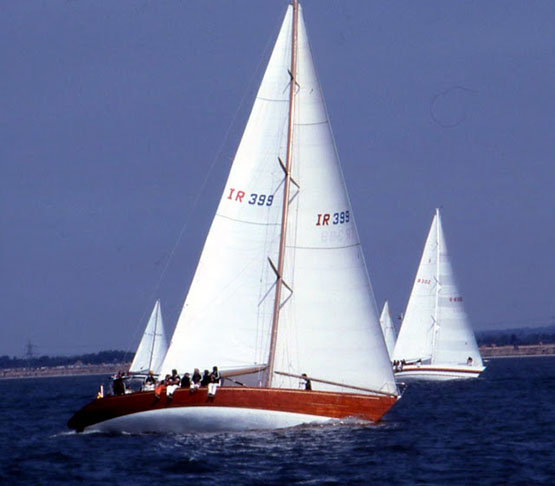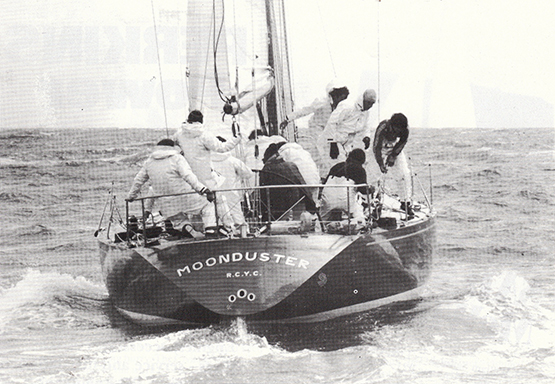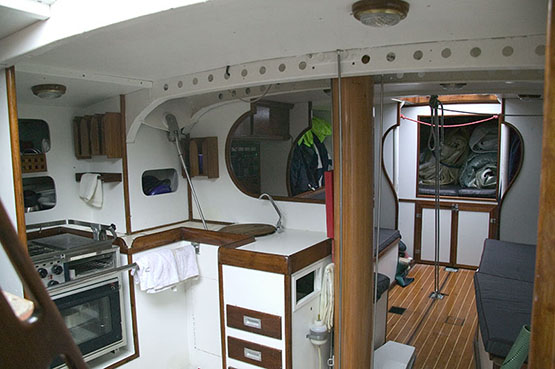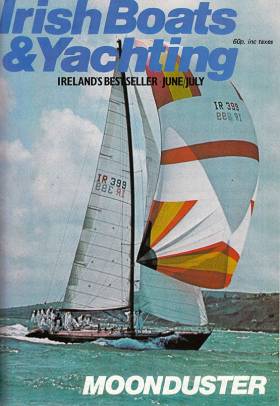Displaying items by tag: Denis Doyle
In the Spring of 1981, Dens Doyle’s Frers 51 Moonduster was launched at Crosshaven into a glittering 20-year partnership in which she and her very special owner-skipper became a much-admired feature of the European offshore racing scene. It was a wonderful double act that ended with his death in 2001, shortly after completing his final Fastnet Race aged 81 aboard his beloved boat.
 When all was hope. The new Moonduster on the cover of the June-July 1981 Irish Boats & Yachting, a briefly-used title for Afloat.ie as we emerged from the economically dead days of the 1970s. Photo: W M Nixon
When all was hope. The new Moonduster on the cover of the June-July 1981 Irish Boats & Yachting, a briefly-used title for Afloat.ie as we emerged from the economically dead days of the 1970s. Photo: W M Nixon
It’s difficult to live in close proximity with a very tangible half of a legend in your midst, so there was something approaching relief in Crosshaven in 2002 when Moonduster and a Dubois 52, which was also stored in the yard, were sold to a seemingly well-resourced Norwegian. He planned to set up an offshore sailing and adventure school at his home town of Trondheim well north along the Norwegian coast, and at first, things seemed to go well.
NORWEGIAN NEWS NOT GOOD
But as communications back to Ireland tapered off over the years, any news coming through was not good. The Dubois 52 was destroyed in a fire, and Moonduster was unused, languishing in the inner dock in Trondheim.
Every so often cruising people bound north, or sailing folk in Trondheim on some other business, have been taking a walk around the harbour to see the boats and admire the character of Trondheim’s sea-trading links to the ancient Hanseatic League. But then their entire day is knocked astray by coming upon this increasingly ghost-like ship of eternal elegance. It can become a sort of haunting, partially exorcised by sending the images of Moonduster’s long slow demise to Afloat.ie, where we have carried the story for more than a dozen years in several features, but all with the message that the owner doesn’t seem to want it to be any other way.
 The fact that this area of Moonduster was once so full of life, with legends of sailing from Cork and abroad, now serves only to emphasise its current near-death situation. Photo: Michael Pearn
The fact that this area of Moonduster was once so full of life, with legends of sailing from Cork and abroad, now serves only to emphasise its current near-death situation. Photo: Michael Pearn
The latest is Michael Pearn, who is English and lives in England, but somehow has become a member of Howth Yacht Club thanks to Susan Kavanagh’s very special administration of the HYC Cruising Group.
TOTALLY MOOD-CHANGING SITUATION
He was recently in Trondheim for his 15-year-old Norwegian grand-daughter’s Confirmation, of which he says: “It’s a big deal in Norway”. Clearly he is not overly familiar with Ireland in First Communion time, regarding which we recently published this universally applicable photo:
 First Communion in a sailing community in Ireland. Photo PSD Nixon
First Communion in a sailing community in Ireland. Photo PSD Nixon
Be that as it may, Michael was taking a stroll around the harbour when he was brought up sharp by finding Moonduster as the grey ghost. Confirmation and First Communion should be times of faith and hope for the future, yet for a while he was mentally knocked astray by this very effective but decidedly scary memento mori.
Knowing that some serious but rejected offers have been made to Trondheim to remedy the situation, we publish these latest images of Moonduster without comment, for her situation is now beyond words.
 When the going was good. Moonduster in her prime in 1995, in the lead soon after the start, and on her way to winning her first Dun Laoghaire to Dingle Race. Photo: Afloat.ie/David O’Brien
When the going was good. Moonduster in her prime in 1995, in the lead soon after the start, and on her way to winning her first Dun Laoghaire to Dingle Race. Photo: Afloat.ie/David O’Brien
This week’s sad video on Afloat.ie about the dilapidated and deteriorating condition of the late Denis Doyle of Cork’s very special Frers 51 Moonduster in northern Norway has led to a flurry of communication on social media, and all sorts of suggestions about how best she might be restored and used in the future. Inevitably, there have been many who reckon she should find her future back home in Ireland, and be properly restored here. W M Nixon isn’t so sure.
There was a period recently when the word “iconic” appeared so frequently as to become meaningless. But fortunately we’ve moved on from that level of gross over-use, and a certain rigour has returned to the deployment of this very useful and eloquent adjective. Which is just as well, for when you try to tell today’s rising generation of offshore sailors just what Denis Doyle and Moonduster meant to us during their twenty years of glory from 1981 to 2001, “iconic” and “inspirational” are the only words which will hit the target.
In fact, the complete force was a threesome, as it was Denis Doyle and his wonderful and supportive wife Mary (nee Woodward) and Moonduster. But even when Mary had passed on in 1993, such was the strength of the team inspired by them that Denis and Moonduster continued actively campaigning at home and abroad with the support of an army of friends. He did his final Fastnet Race with Moonduster in 2001 aged 81, and was gone from among us by the Autumn.
To say that Moonduster looked forlorn in the big shed in the winter of 1981-82 at Crosshaven Boatyard where she had been built is scarcely to begin to grasp just what “The Doyler and The Duster” had meant to Cork and to Irish sailing and to world offshore racing. They represented a level of commitment to the sport and to the communities it involved which few other people-and-boat combinations could match.
Awareness of this first came to me this in Cowes in the summer of 1969, when we’d taken a 35ft boat we built in Carrickmacross (as one does) down south to do Cowes Week and the Fastnet Race. We seemed to spend a lot of time in Groves & Guttridge’s yard with much hammering being heard from within our County Monaghan boat, and our only consolation was that there was even heavier hammering coming from within Dick Carter’s innovative Red Rooster beside us on the hard, with her huge lifting keel continuing to give problems.
Subsequently, Red Roooster went on to win overall in the Fastnet, while we with our very homemade boat were 122nd out of 250 entries - it truly took a helluva lot of boats to beat us. Yet it takes an effort to remember all that. But what I do remember vividly is a little exchange on the balcony of the Island Sailing Club where I was taking a break from the boatyard mayhem and maybe enjoying a beer or three, and certainly a breath of fresh air in the sunshine, as the last of the fleet from that day’s New York Yacht Club Cup race came into port.
Conspicuous among them was Denis Doyle’s first Moonduster, the very handsome Robert Clark-designed white 47–footer built in Crosshaven Boatyard in 1965. Moonduster was particularly conspicuous because, unlike the other boats coming up the Medina River under engine, she was being sailed by Denis with consummate skill, for he disdained to have an auxiliary engine, as had also been the case with his first Crosshaven-built Robert Clark offshore racer, the 38ft Querida of 1963.

The Solent was only one of many venues to which Denis & Mary Doyle & Moonduster gave total commitment. This is the new Moonduster racing in the Admirals Cup of 1981.
Foolishly, I made some quip about the mad Doyler and his engine-less boat to a formidable matron who was beside me in the balcony crowd. She put me very firmly in my place. It emerged she was Denis and Mary’s Cowes landlady, and she was on the balcony to see her hero sail into port. It seemed that, ever since Denis and Mary and whatever boat they happened to be campaigning that year had been coming to Cowes, after careful research they’d selected this woman’s Bed & Breakfast to be their Cowes base. And they had stayed loyally and on the best of terms with her ever since. In the hierarchy of Cowes landladies, this put her very high up the pecking order.
“If a few more of these supposed gentlemen yachtsmen coming to Cowes Week brought the same sense and level of support, respect, generosity, consideration and kindness to the local folk as Mr & Mrs Doyle do, then Cowes would be a much more prosperous and happy little town” I was crisply informed.
You remember little exchanges like that long after numerous Cowes Weeks and three Fastnet Races have become a hazy memory. And the sign-off line was the killer punch. “On top of their friendliness, after Mary has seen Denis off in the Fastnet Race or whatever race is taking Moonduster away from Cowes, she’ll always drop by to say goodbye until next time, and present me with a lovely bouquet of flowers”.
The Doyler’s boat-owning history was fascinating. His first higher- visbility campaigning was with a Cork Harbour OD, but then for a while he took his first serious steps offshore with the converted 6 Metre Vaara. But it was with the 30 Square Metre Vanja IV – which he bought from Lough Derg – that he began to do more serious offshore stuff verging on into RORC events, which he continued with the “Straight Eight” Severn II, one of a group of impressive International 8 Metres which set the tone in Crosshaven in the 1950s and 60s.
However, having bought Crosshaven Boatyard to add to his extensive maritime business portfolio, he linked up with that noted designer of elegant offshore racers Robert Clark to build the 38ft Querida in 1963, and the much-loved 47ft white Moonduster (named after a racehorse) in 1965, with the link-up reaching a peak with Francis Chichester’s last boat, the Clark-designed Gypsy Moth V, in 1970.
As for Denis Doyle, the white Moonduster was succeeded in 1973 by the blue Moonduster, a massively powerful 47ft Sparkman & Stephens design which, alas, came to an unhappy end in the Pacific some years ago. But Denis Doyle had long since moved on, for after her for two or three years he had a fibreglass Ron Holland-designed Swan 44, a standard boat which couldn’t quite compete with one-offs, yet she was the only member of the Irish Admirals Cup Team of 1979 which managed to finish the disastrously storm-tossed Fastnet Race of that year.
But by 1980 The Doyler’s heart was set on a new Frers 51-footer which was to be wooden built multi-skinned in Crosshaven Boatyard. She was the absolute essence of Frers in style and appearance, yet the name Moonduster appears only once in an offhand sort of reference in the official Frers book, A Passion for Design. For if memory serves aright, German Frers allowed Dick Leonard of Crosshaven Boatyard access to the lines of the hugely successful alloy-built Frers 51 footer Blizzard, and Dick went to work and developed the detailed plans for wooden construction while the young up-and-coming Crosshaven designer Tony Castro was called in as consultant when added expert help was needed.
Thus Moonduster may have been Frers without, but she was pure Crosshaven within. And my goodness, but she was good-looking. When she first appeared in the nick of time for the Irish Admirals Cup trials in May 1981, you didn’t really look at any other boat. An elegantly varnished hull with effortlessly powerful performance, this new Moonduster was a yacht as yachts should be.

“An elegantly varnished hull with effortlessly powerful performance…..” Moonduster off Cork in May 1981. Photo: W M Nixon

“There was only one boat to look at”. Moonduster leading the fleet in the 1981 trials. Photo: W M Nixon

Moonduster’s interior is functional yet attractive
And though in some sense she may have been “unofficial Frers”, all I know is that a few month after her successful first season, when the 1982 Falklands War was under way I received a circuitous request from Buenos Aires for a print suitable for framing and wall-hanging of that photo of mine which appeared in the poorly-printed cover of the June/July 1981 Irish Boats & Yachting, one of the incarnations of Afloat. In due course, the carefully rolled and packaged print found its way past the war and on into Argentina and the Frers establishment, where presumably it joined the wall display among other classic Frers designs where Moonduster so rightly belonged.
But getting the photo to Mr Frers was only the beginning of The Last Moonduster Story. In 1982 Denis and Mary and Moonduster committed themselves to the Round Ireland Race and Wicklow with the same devotion that they gave to the Fastnet Race and Cowes in alternate years, and it was the making of the event, with Moonduster establishing a good record in 1982, and then an incredibly good Round Ireland record in 1984 which stood for many years.

The beginnning of a great relationship – Moonduster approaching Wicklow for the finish of the Round Ireland Race of 1982.

“The gang’s all here”. Moonduster on the way to her enduring Round Ireland record in the race of 1984, with Neil Hegarty on the helm (left), Donal McClement on the mainsheet, Brendan Fogarty (foreground), Davy Harte, and the late Grattan Roberts.
But involvement with Wicklow and Cowes at the appropriate times was only part of the Moonduster mystique. Another indirect Moonduster recollection that springs to mind is of stepping in to the Club Nautico de Montereale or whatever it’s called in Bayona in northwest Spain in 1995 after sailing out from Ireland across Biscay, and there was the Commodore honours board and beside it the honorary members list, and the top of the latter was one King Juan Carlos and beside him was Denis N Doyle. Moonduster enjoyed bringing a bit of real style to the scene in northwest Spain, while Juan Carlos was an old friend from the Admirals Cup years of the mid-70s, and they partied mightily when he came aboard Moonduster at Cabrera when the Irish boat was on her way to the Sardinia Cup at Costa Smeralda.
But whoever it was, king or crewman, Denis was the same utterly straight Denis Doyle. Photographers tried to capture the spirit of this very remarkable man, but it was impossible to get the essence of his character, for without being a fidget in any way, he was a man of action, and his character was most purely expressed through what he did.

Even the best photographers had difficulty in capturing the essence of Denis Doyle in a portrait, for he was what he did. Photo courtesy RCYC
So when he died, it was only natural that nobody in Cork or Ireland wanted to take on Moonduster. It was a great relief when eventually she was sold to Trondheim far in the north of Norway for a sail training school, for in some ways that was what she had been in the Doyle ownership, with his great shipmate Colonel Barney Goulding introducing platoons of young soliders who became great crewmen, for unlike navy cadets, they didn’t come aboard with any preconceived notion of how a boat should be sailed and run.
But now the care of Moonduster in Norway has apparently gone pear-shaped and beyond. A saviour and guardian angel is urgently required. And if you insist and can organise it, by all means get her restored to full health in Ireland. But once that’s done, please take her away to join the classic offshore racers group in the Mediterranean. Take her away and keep her away for a good while yet. Fifteen years may have passed. But we’re still not ready to see Moonduster sailing in Ireland again without The Doyler at the helm.

In her early days in Norway, Moonduster seemed to have settled well in her new home
























































